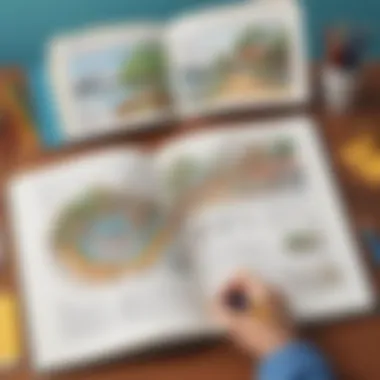Elevate Your Learning: Visual Learners' Guide to Study Tools Optimization


Creatvie Activities
- Craft Ideas: Some creative craft ideas that children can easily replicate include origami sessions to boost spatial awareness or painting classes to stimulate creativity. These hands-on activities not only enhance motor skills but also foster a sense of accomplishment.
- Step-by-Step Guides: Detailed instructions play a crucial role in ensuring that children can follow the activities independently. From listing the required materials to providing step-by-step procedures, clear guidelines are essential for a seamless creative experience.
- Educational Value: Engaging in these creative activities goes beyond mere entertainment; they offer substantial educational benefits. For instance, crafting a model volcano can teach children about geological processes, making learning a hands-on experience.
Fun Quizzes
Adding a dash of fun to the learning process, interactive quizzes provide an exciting way for visual learners to reinforce their understanding of various topics. These quizzes not only test knowledge but also serve as a tool for memory retention. By making learning enjoyable, quizzes on ElemFun engage children in a unique learning experience which is both fun and educational.
- Quiz Topics: Topics covered in the quizzes on ElemFun range from basic mathematics to historical facts, allowing children to explore diverse subjects and broaden their knowledge base.
- Question Types: To keep children engaged, a variety of question types are used in the quizzes, including multiple-choice, true or false, and fill-in-the-blank. This variety ensures that learners stay actively involved throughout the quiz.
- Knowledge Reinforcement: Quizzes offered on ElemFun aim to reinforce learning by presenting questions that challenge children's understanding. Through consistent practice and engaging quizzes, children can solidify their grasp of various concepts and topics.
Fact-Based Articles
Equipping visual learners with accurate information is vital, and fact-based articles serve as a valuable resource in achieving this goal. With a focus on presenting information in an engaging and easy-to-understand manner, these articles provide valuable insights across a broad spectrum of topics. By delving into diverse subjects, children can expand their knowledge horizons and enhance their understanding of the world around them.
- Topics: The articles cover a wide array of topics, ranging from scientific discoveries to historical events, offering children a comprehensive view of different realms of knowledge.
- Engaging Content: Presenting information in an engaging format is key to capturing children's interest. Through interactive visuals and simplified language, these articles make complex concepts more accessible and digestible for young readers.
- Additional Resources: To further enrich children's learning experience, additional resources such as related articles and external links are provided. This encourages children to explore beyond the scope of the article, fostering a spirit of curiosity and continuous learning.
Understanding Visual Learners
Understanding Visual Learners is a pivotal aspect of this article on study tools. Visual learners possess unique characteristics that set them apart from other types of learners. In the realm of education, catering to visual learners is crucial for maximizing learning potential. By delving into the distinctive traits and preferences of visual learners, this article aims to provide valuable insights that can revolutionize the learning experience for this specific group of individuals. Understanding Visual Learners forms the foundation upon which the entire discussion on study tools for visual learners is built, offering a roadmap for effective learning strategies.
Characteristics of Visual Learners
Strong Preference for Visual Information
Visual learners exhibit a strong inclination towards processing information in a visual format. This preference stems from their enhanced ability to comprehend and retain information when presented visually. By gravitating towards images, graphs, and charts, visual learners can better grasp complex concepts and connect ideas effectively. This prominence of visual information plays a pivotal role in their learning journey, shaping the way they engage with educational material and derive meaning from it. The unique characteristic of a strong preference for visual information distinguishes visual learners from auditory or kinesthetic learners, underscoring the significance of tailored approaches to meet their specific needs.


Engage Well with Graphs, Charts, and Infographics
Another defining trait of visual learners is their adeptness at engaging with graphs, charts, and infographics. These visual aids serve as powerful tools for visual learners to assimilate information efficiently. By presenting data in a visual manner, such as through graphs illustrating trends or infographics condensing complex concepts, visual learners can improve their comprehension and retention levels. The ability to engage effectively with visual representations enhances the learning experience for visual learners, allowing them to decipher intricate information with ease. Embracing graphs, charts, and infographics as primary sources of learning material empowers visual learners to navigate the educational landscape with confidence.
Learning Strategies for Visual Learners
Mind Mapping Techniques
Mind mapping techniques are instrumental for visual learners in organizing and connecting key ideas. Through the use of visual diagrams that capture relationships between concepts, visual learners can create structured representations of information. Mind mapping harnesses the spatial and visual intelligence of visual learners, enabling them to outline concepts in a coherent and meaningful way. This method enhances retention and facilitates a deeper understanding of subject matter, making it a popular choice among visual learners seeking effective study tools.
Color Coding Systems
Color coding systems offer visual learners a practical way to categorize and prioritize information. By assigning specific colors to different categories or topics, visual learners can quickly distinguish between various elements. This visual differentiation aids in organizing study material and creating visual associations, reinforcing memory retention. Color coding systems provide a systematic approach to information processing, enhancing the efficiency of studying for visual learners. The visual appeal and structure offered by color coding systems make them a valuable asset for visual learners aiming to optimize their study sessions.
Essential Study Tools
In the realm of educational optimization for visual learners, the utilization of essential study tools plays a vital role in augmenting the learning experience. These tools serve as catalysts for comprehension and retention, facilitating an efficient way to absorb and process information. Among the myriad of study tools available, essential tools cater specifically to visual learners, taking into account their unique preferences and learning styles. By incorporating interactive apps, digital flashcards, infographics, and video-based platforms, visual learners can leverage these tools to enhance their educational journey.
Interactive Learning Apps
Khan Academy Kids
Khan Academy Kids, a popular choice among educational apps, plays a pivotal role in providing interactive and engaging content tailored to young learners. This app offers a diverse range of subjects and topics presented in a visually stimulating manner, capturing the attention of visual learners effectively. The intuitive interface and visually appealing graphics of Khan Academy Kids foster a conducive learning environment, where children can explore and absorb educational material seamlessly. However, despite its advantages, Khan Academy Kids may face challenges in content depth and customization options.
Quizlet
Quizlet, renowned for its comprehensive study tools, contributes significantly to the visual learning experience. By offering interactive flashcards, quizzes, and study games, Quizlet appeals to visual learners seeking an immersive study experience. The multimedia features of Quizlet enable users to engage with content dynamically and enhance their retention abilities. Moreover, the collaborative nature of Quizlet allows for shared study resources, adding a community aspect to the learning process. Nonetheless, Quizlet may encounter limitations in content authenticity and depth, requiring users to supplement their study materials.


Digital Flashcards and Infographics
Cram
Cram, an essential tool in the visual learner's arsenal, streamlines the study process through digital flashcards. With customizable features and a user-friendly interface, Cram enables users to create visually appealing flashcards adorned with images and diagrams. This visual reinforcement enhances memory recall and aids in information retention, making complex concepts more digestible for visual learners. Despite its benefits, Cram may have limitations regarding advanced features and collaborative functionalities.
Canva
Canva stands out as a versatile platform for creating aesthetically pleasing infographics tailored to visual learners. Its user-friendly design tools and vast template library empower users to design informative visuals that resonate with the visually inclined. By incorporating color schemes and graphic elements, Canva transforms data into engaging visuals, facilitating a deeper understanding of complex information. However, while Canva excels in graphic design capabilities, it may have constraints related to data integration and interactivity in infographics.
Video-Based Learning Platforms
TED-Ed
TED-Ed, a hub for educational videos, enriches the visual learning experience with its engaging and informative content. The storytelling approach of TED-Ed captivates learners, making complex topics accessible through visual narratives. By combining animation and expert insights, TED-Ed delivers educational content in a visually compelling format that resonates with visual learners. Nevertheless, TED-Ed may encounter challenges in content variety and interactive learning components.
Crash Course
Crash Course, known for its concise and engaging educational videos, offers visual learners a unique avenue to dive into diverse subjects. The fast-paced yet informative style of Crash Course caters to the dynamic nature of visual learners, keeping them engaged and intrigued throughout each video. With a focus on visual storytelling and interactive elements, Crash Course bridges the gap between educational content and visual engagement. However, Crash Course may have drawbacks in terms of in-depth exploration of complex topics and interactive learning dynamics.
Innovative Techniques for Visual Learners
In the complex landscape of educational methodologies, the need for innovative techniques specifically tailored for visual learners becomes paramount. This article delves into the realm of study tools curated to amplify the learning experience of visual learners, catering to their unique cognitive strengths and preferences. By exploring cutting-edge methods and tools, we aim to provide a comprehensive guide that not only enhances educational outcomes but also fosters a deeper appreciation for the process of learning through visual stimuli. For visual learners, these innovative techniques serve as a bridge between traditional pedagogy and the evolving demands of the digital age.
Virtual Reality Learning


Immersive Educational Experiences
Within the domain of visual learning, the concept of immersive educational experiences stands as a beacon of technological advancement and pedagogical innovation. By immersing learners in simulated environments, virtual reality not only enhances engagement but also facilitates experiential learning on a profound level. The key characteristic of immersive educational experiences lies in their ability to transport learners beyond the confines of traditional classrooms, plunging them into dynamic, interactive settings where learning transcends mere theoretical comprehension. The unique feature of immersive educational experiences is the creation of a sensory-rich ecosystem that appeals to visual learners' innate curiosity and desire for hands-on exploration. While virtual reality offers unparalleled opportunities for holistic learning, it also poses challenges such as potential sensory overload or detachment from reality. Nevertheless, within the context of this article, immersive educational experiences emerge as a powerful tool for engrossing visual learners in a realm where education merges seamlessly with innovation and imagination.
Augmented Reality Applications
Interactive Learning Simulations
Augmented reality applications introduce a new dimension to visual learning through interactive learning simulations that blur the lines between virtual and physical realms. The key characteristic of interactive learning simulations lies in their ability to overlay digital content onto real-world environments, creating a dynamic fusion of tangible and digital elements that captivate learners. By merging virtual objects with the physical world, augmented reality offers visual learners a dynamic platform for visualizing complex concepts and engaging with educational content in a highly interactive manner. The unique feature of interactive learning simulations is their capacity to provide personalized learning experiences, tailoring educational content to suit individual learning styles and preferences. While augmented reality applications enrich the learning process with hands-on interactivity, they may also present challenges such as technical constraints or cognitive overload. Nonetheless, within the context of this article, interactive learning simulations emerge as a transformative tool for visual learners, unleashing boundless possibilities for immersive, engaging, and personalized educational experiences.
Maximizing Study Sessions
Maximising Stud Sessions plays a crucial role in optimising the learning process for visual learners. By honing in on the visual aspects of studying, learners can enhance their comprehension and retention levels significantly. There exist several crucial elements that one must consider when aiming to maximise study sessions effectively. These elements include the incorporation of various visual aids, the strategic utilisation of interactive learning tools, and the creation of an engaging study environment that catalyses visual thinking processes. Properly maximising study sessions allows visual learners to delve deep into complex concepts, break down information into digestible visual chunks, and navigate their learning journey with clarity and enhanced concentration. Through maximising study sessions, visual learners can extract the utmost value from their educational endeavours, leading to improved academic performance and a heightened sense of confidence in their learning capabilities.
Creating Visual Study Guides
Utilizing Mind Maps
Drawing from its innate effectiveness in structuring and connecting information visually, utilising Mind Maps serves as a pivotal strategy in optimising study sessions. Mind Maps offer a holistic view of a topic, enabling learners to map out relationships between concepts, identify core ideas, and create an interconnected visual representation of knowledge. The key characteristic of utilising Mind Maps lies in its ability to enhance memory retention by leveraging spatial organization and visual cues. Moreover, incorporating colors and symbols in Mind Maps further aids in information recall and stimulates creative thinking. The unique feature of Mind Maps lies in their nonlinear structure, allowing learners to explore ideas freely and develop a more profound understanding of complex subjects. While Mind Maps offer a versatile and engaging approach to visual learning, it's essential to note that they may require initial guidance for learners unfamiliar with this technique.
Incorporating Images and Diagrams
Another effective method in creating visual study guides involves the incorporation of images and diagrams to reinforce learning. By integrating relevant visuals alongside textual content, learners can engage multiple senses and reinforce their understanding of concepts. The key characteristic of incorporating images and diagrams lies in their capability to convey information in a concise and impactful manner, aiding visual learners in grasping complex ideas intuitively. Utilising diagrams can simplify abstract concepts, enhance information retention, and cater to different learning styles through visual representation. The unique feature of incorporating images and diagrams rests in their ability to facilitate active learning by encouraging learners to draw connections between visual elements and textual information, fostering a deeper understanding of the subject matter. While images and diagrams can enhance learning outcomes significantly, careful selection and integration of visuals are vital to ensure the coherence and effectiveness of study guides.
Utilizing Whiteboards and Drawing
Problem-Solving Visualizations
When seeking to maximise study sessions, the integration of problem-solving visualizations through whiteboards and drawing emerges as a practical and engaging strategy for visual learners. Problem-solving visualizations enable learners to break down complex problems into visual representations, facilitating a systematic approach to tackling challenging concepts. The key characteristic of problem-solving visualizations lies in their capacity to foster analytical thinking and promote a structured problem-solving methodology. By visually mapping out problem-solving strategies and depicting key steps through illustrations, learners can develop a deeper understanding of problem-solving processes.
Concept Mapping
Similarly, concept mapping serves as an invaluable tool in maximising study sessions for visual learners. Through the creation of concept maps, learners can visually organize and connect concepts, establishing relationships between ideas and enhancing information retrieval. The key characteristic of concept mapping lies in its ability to encourage critical thinking by requiring learners to identify key concepts, hierarchies, and interconnections within a topic. Concept mapping facilitates meaningful learning by allowing learners to construct mental frameworks of knowledge visually, aiding in concept comprehension and knowledge retention. The unique feature of concept mapping lies in its adaptability to various subjects and topics, making it a versatile tool for visual learners across different educational domains. While concept mapping enhances cognitive processes and supports holistic understanding of subjects, learners may benefit from guidance in mastering complex mapping techniques to maximise its efficacy in study sessions.







